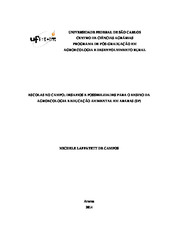| dc.contributor.author | Campos, Michele Laffayett de | |
| dc.date.accessioned | 2016-06-02T18:57:50Z | |
| dc.date.available | 2014-07-21 | |
| dc.date.available | 2016-06-02T18:57:50Z | |
| dc.date.issued | 2014-04-04 | |
| dc.identifier.citation | CAMPOS, Michele Laffayett de. Schools in the field: challenges and possibilities for agroecology and environmental education teaching in Araras (SP). 2014. 230 f. Dissertação (Mestrado em Ciências Agrárias) - Universidade Federal de São Carlos, Araras, 2014. | por |
| dc.identifier.uri | https://repositorio.ufscar.br/handle/ufscar/171 | |
| dc.description.abstract | This research discusses the challenges and opportunities for Agroecological Education and Environmental Education (EE) in two rural schools from Araras - SP. The objectives were to understand the state curriculum frameworks of rural schools and the municipal school field , understand and map the different conceptions of Environmental Education and Agroecology and identify how these issues are being developed in rural school environments and how to dialogue with the Course Proposal State of Sao Paulo. The research was conducted in a qualitative way and used the research methodology - action - participatory. Data were collected through visits , training of group discussions and actions, conversations, interviews, participant observations, school life, documentary analysis and Participatory Diagnostic School . Three categories of analysis were defined , namely: 1) the mainstreaming of EE practices, 2) the relationship of curriculum content with the social context , and 3) consistency of approach with rural reality. It was found that the state promotes rural school practices EE, but are not transverse , are not critical and are characterized by being disconnected from the social context and the reality of their students. The school promotes a biologicist, behavioral, and unidirectional pre - established concept of EE , arising from Directive Course of São Paulo, which uses parameters of urban education and has no agricultural disciplines nor the Agroecological education. The school has cross municipal field , critical and connected to the social context EE. The approaches of this school are in accordance with the reality of their students by having the Agroecological education and other disciplines and workshops that are tailored to the countryside and the environment . Therefore , it is concluded that the field school directed by the Field Operational Guidelines for School , shows how Agroecology and EE, the value the field, the peasant and the traditional knowledge, are realized as tools to achieve the goals of contextualizing education and to ensure the sustainability field. | eng |
| dc.description.sponsorship | Financiadora de Estudos e Projetos | |
| dc.format | application/pdf | por |
| dc.language | por | por |
| dc.publisher | Universidade Federal de São Carlos | por |
| dc.rights | Acesso Aberto | por |
| dc.subject | Agroecologia | por |
| dc.subject | Educação do campo | por |
| dc.subject | Educação rural | por |
| dc.subject | Matrizes curriculares | por |
| dc.subject | Ruralidades | por |
| dc.subject | Rural education | eng |
| dc.subject | Ruralities | eng |
| dc.subject | Curriculum matrices | eng |
| dc.title | Escolas no campo: desafios e possibilidades para o ensino da agroecologia e educação ambiental em Araras (SP) | por |
| dc.title.alternative | Schools in the field: challenges and possibilities for agroecology and environmental education teaching in Araras (SP) | eng |
| dc.type | Dissertação | por |
| dc.contributor.advisor1 | Bertazzo, Cláudio José | |
| dc.contributor.advisor1Lattes | http://lattes.cnpq.br/1154385746854757 | por |
| dc.description.resumo | A presente pesquisa discute os desafios e as possibilidades para o ensino da Agroecologia e a Educação Ambiental (EA) em duas escolas rurais do município de Araras - SP. Os objetivos gerais foram compreender o cotidiano, os processos de ensino e aprendizagem e as estruturas curriculares de uma Escola Rural Estadual e outra Escola do Campo Municipal situadas no município de Araras - SP, evidenciando as diferenças entre ambas e; mapear as diferentes concepções de agroecologia e educação ambiental, identificando como essas temáticas vêm sendo desenvolvidas nos espaços escolares e como dialogam com a Política Pública Educacional do Estado de São Paulo. A pesquisa foi desenvolvida numa perspectiva qualitativa e utilizou-se a metodologia de pesquisa - ação - participativa. Os dados foram coletados mediante visitas, formação de grupos de discussões e ações, conversas, entrevistas, observações participantes, vivência escolar, análises documentais e Diagnóstico Escolar Participativo. Foram definidas três categorias de análise, a saber: 1) a transversalidade das práticas de EA; 2) a relação dos conteúdos curriculares com o contexto social; e, 3) a coerência das abordagens com a realidade rural. Constatou-se que a escola rural estadual promove práticas de EA, mas que não são transversais, não são críticas e se caracterizam por serem desconectadas do contexto social e da realidade de seus educandos. A escola privilegia uma concepção biologicista, comportamental, unidirecional e pré-estabelecida de EA, oriunda da Diretriz Curricular do Estado de São Paulo, que utiliza parâmetros urbanos de ensino e não possui disciplinas agrícolas e tampouco o ensino da Agroecologia. A escola do campo municipal possui EA transversal, crítica e conectadas ao contexto social. As abordagens desta escola estão em conformidade com a realidade de seus educandos por possuir o ensino da Agroecologia e outras disciplinas e oficinas que são adaptadas ao campo e ao meio ambiente. Assim sendo, conclui-se que a escola do campo orientada pelas Diretrizes Operacionais de Escola do Campo, mostra como a Agroecologia e a EA, ao valorizarem o campo, o camponês e os conhecimentos tradicionais, se concretizam como ferramentas para se alcançar os objetivos de contextualizar a educação e de garantir a sustentabilidade no campo. | por |
| dc.publisher.country | BR | por |
| dc.publisher.initials | UFSCar | por |
| dc.publisher.program | Programa de Pós-Graduação em Agroecologia e Desenvolvimento Rural - PPGADR-Ar | por |
| dc.subject.cnpq | CIENCIAS AGRARIAS | por |
| dc.contributor.authorlattes | http://lattes.cnpq.br/4952486659825164 | por |
